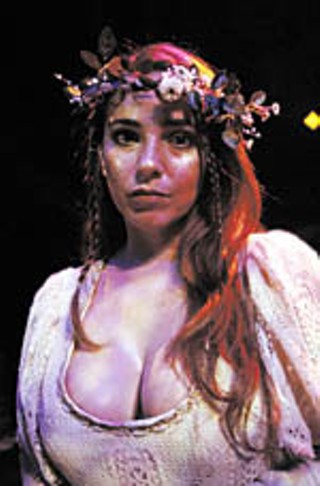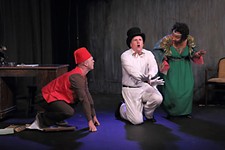Dark Goddess 2004
Local Arts Reviews
Reviewed by Robert Faires, Fri., March 12, 2004

Dark Goddess 2004
The Vortex, through March 28Running Time: 1 hr, 50 min
The modern world doesn't hold much truck with transformation. Oh, it accepts the kind that comes through color in a bottle or the surgeon's scalpel, but anything more involved than an extreme makeover – say, metamorphosis into a bird or, heaven forbid, the alteration of one's inner self – has no business in this high-speed, digitally modified culture of low-carb diets and plasma screen TVs, iPods and Botox injections.
No doubt that's why director Bonnie Cullum makes such a point of pulling you out of that world for Dark Goddess. She has each audience member greeted individually at the door to the theatre and asked if she or he is willing to enter the space, after which the person is blessed with a dab of oil on the forehead. The set created by Ann Marie Gordon has the look and feel of a primeval grotto, large flat stones over which are suspended long bare limbs from trees, and Jason Amato's lights bathe it in primal, primary hues – oceanic blues and hellish reds. The opening invocation by Morgan Le Fay – yes, she of Arthurian legend but present here as queen of the faery folk – transports us to the "world between worlds," a place removed from our technology-bound present and our everyday cares about jobs, traffic jams, and so forth.
That distance helps you appreciate the goddesses and priestesses represented here in all their mythic power. The 12 in this year's ritual – the fourth such that Vortex Repertory Company has produced – encompass creators (the Maori Hine Turama, mother of the stars; the Star of the Sea, mother of the oceans) and a destroyer (the Hindu goddess Kali); those who bring fertility (the Irish Sheila-na-gig, the Babylonian Ishtar, and the Aztec Tonantzin) and those who cast spells (Morgan Le Fay and the Greek sorceress Circe); and divinities whose power lies in the animal world (the Native American Bear Woman and the North African serpent goddess Medusa). Each in turn takes center stage in the ceremony, relating her story or proclaiming her strength in performance. Dance is used to show us Ishtar's descent into the underworld and Medusa's mysteries (the latter beguilingly danced by Nadia Feltes with a snake); song communicates the compassion of Star of the Sea and the earthy blessings of Sheila-na-gig (the fearless Jo Beth Henderson, nearly naked and slathered in mud, belting it out as R&B). The 11 performers here immerse themselves in these female divinities, abandoning their contemporary identities in an effort to will these ancient sources of wisdom and strength back into our consciousness, to become them that we might know them.
Transformation is a recurring theme – the Aztec Tonantzin becoming the Catholic Virgen de Guadalupe after the native Mexicans' conversion to Christianity, the Welsh flower creature Blodeuwedd being turned into an owl, Kali sowing destruction that allows for new creation – that is there to instruct us. "Take responsibility for your own transformation," the women tell us. "Change is eternal. Accept change. Embrace it." It's an old truth we might typically brush past in our rush to stay the same, look young, be hip. But disconnected from the distractions and disbelief of contemporary culture, it has a chance for new life. In the womb of the Vortex, nurtured by this ritual, it becomes ... a possibility.










